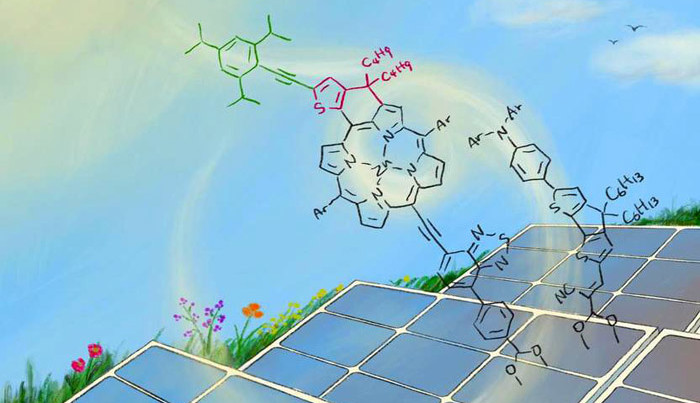Dye-Sensitized Solar Cells Get a Boost
June 24, 2019
on
on

Japanese researchers have developed a dye-sensitized solar cell using methylene bridged material, fused to the porphyrin core to achieve an efficiency of 10.7%.
Researchers at Kyoto University's Institute of Integrated Cell Material Sciences have made a well-known type of dye-sensitized solar cell much more efficient by modifying its structure. The research report published in the Journal of the American Chemical Society (JACS) outlines a number of improvements to reach an efficiency of 10.7% – the highest efficiency ever for this type of dye-sensitized solar cell. There is however potential to increase this further to the theoretical 30% limit.
Current dye-sensitized solar cells are made up of a porous layer of titanium dioxide covered with a molecular dye. As sunlight is absorbed, electrons become excited and are collected to provide a flow of electrical power, before they are reintroduced into the electrolyte and back to the dye molecule. A practical and robust dye-sensitized solar cell could be a low-cost and lightweight alternative to the more conventional silicon-based solar cell but current designs have yielded poor efficiency.
There are various approaches to structuring these solar cells; aromatic ring fusion to a porphyrin core is the most attractive because this material absorbs red light well. But the among its disadvantages are that the electrons are stimulated for a short time only and are only briefly available to produce electrical energy and the electrons also have a tendency to aggregate.
To improve efficiency, Japanese researchers have been investigating the use of a methylene-bonded material fused to the porphyrin core. This structure prevents the aggregation of electrons and improves energy conversion.
The new molecular dye DfZnP-iPr, was able to achieve a significantly higher efficiency than previous dye-sensitized solar cell models and should provide a boost to the development of future high-performance low-cost PV cells.
Researchers at Kyoto University's Institute of Integrated Cell Material Sciences have made a well-known type of dye-sensitized solar cell much more efficient by modifying its structure. The research report published in the Journal of the American Chemical Society (JACS) outlines a number of improvements to reach an efficiency of 10.7% – the highest efficiency ever for this type of dye-sensitized solar cell. There is however potential to increase this further to the theoretical 30% limit.
Current dye-sensitized solar cells are made up of a porous layer of titanium dioxide covered with a molecular dye. As sunlight is absorbed, electrons become excited and are collected to provide a flow of electrical power, before they are reintroduced into the electrolyte and back to the dye molecule. A practical and robust dye-sensitized solar cell could be a low-cost and lightweight alternative to the more conventional silicon-based solar cell but current designs have yielded poor efficiency.
There are various approaches to structuring these solar cells; aromatic ring fusion to a porphyrin core is the most attractive because this material absorbs red light well. But the among its disadvantages are that the electrons are stimulated for a short time only and are only briefly available to produce electrical energy and the electrons also have a tendency to aggregate.
To improve efficiency, Japanese researchers have been investigating the use of a methylene-bonded material fused to the porphyrin core. This structure prevents the aggregation of electrons and improves energy conversion.
The new molecular dye DfZnP-iPr, was able to achieve a significantly higher efficiency than previous dye-sensitized solar cell models and should provide a boost to the development of future high-performance low-cost PV cells.
Read full article
Hide full article



Discussion (0 comments)